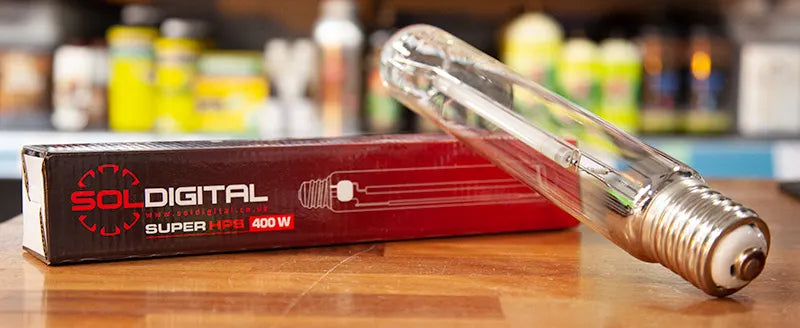Different Types of Lights
Choosing a grow light is one of the most important aspects of your indoor setup. You’ll need to have a think about the space the light is going to be illuminating, the output of the light and the power consumption.
The three most important lighting types to consider right now are:
Each of these has different characteristics that you ought to think about when choosing your ideal grow light.

HPS is still the most popular type of grow light at the moment, with 600w set-ups being the most common. 600w HPS lights are perfect for illuminating 1.2m x 1.2m grow areas. There are also 1000w and 400w variants available (although the 400w versions can be hard to find these days) which perform better in different spaces.
HPS lights are made up of 3 main components, a lamp (or bulb) which outputs the light, a reflector, which pushes all the lamps light down onto your plants, and a ballast which regulates mains electric current and voltage into a form suitable to start up and run your lamp.
The light output from HPS is super-intense, their powerful output will penetrate your canopy with ease. The better a lights penetration, the lower down your plant you will get developed fruits and ultimately an increased yield. It’s renowned for being particularly heavy in the red area of the spectrum. This helps plants to pile on tons of extra weight during the bloom stages.
It’s no wonder that HPS lights have built up such a solid reputation: they’re low priced (starting at only fifty quid for one of our budget kits) and they really do get the job done. That’s why they’ve been the industry standard for decades.

The light on the right is a CDM. The light on the left is a HPS.
The biggest selling-point of CDM lighting is the fact that it delivers full-spectrum light that mimics the sun. Whereas HPS lighting is concentrated pretty much exclusively in the red areas, CDM lighting has high levels of light right the way across the spectrum. This has a massive overall impact on plant health, growth rates and vigour, as well as increasing natural oil production for a superior tasting end-product.
They come with higher price tags than HPS systems, but they’re easily worth the trade-up. That’s because, according to customer feedback, a typical 315 watt HPS lamp can deliver results that are equal to around 500 watts of HPS, while also running cooler. And, because you’re adding less heat to your grow-room, your environment is much easier to control.
As an added bonus, CDMs also produce low levels of UVA and UVB. In the short term, UV light actually has a damaging effect on plants. The good news is that plants’ solution to this problem is to produce even more essential oil to protect themselves, further improving aromas and flavours, while piling on additional weight! UV can also help to control pathogenic fungi like powdery mildew and botrytis, helping to prevent and control diseases that can cost you your entire crop.

One of the best investments a grower can make is to move over to a high quality LED grow light such as one of the Maxibright Daylight models or the Lumatek Zeus Pros. LED grow lights are more efficient than HPS and CDM grow lights and offer an even better spread and spectrum. Feedback from customers is that they are surprised at the results they are getting from them!
Recent advances in LED technology have put them at the front of the pack for what grow lights can do with a given amount of energy and space. There's no lamps to change out and they last for many years. There's less heat to contend with due to their efficiency. The spread and the coverage is awesome. The "spider" arrangement of those two brands means that no corner of a tent is left unlit, so every part of the plant has the best chance to be as productive as possible.

